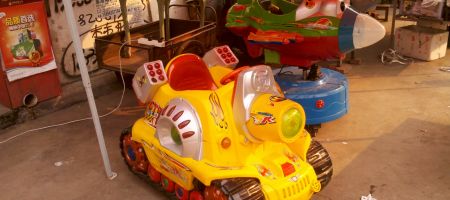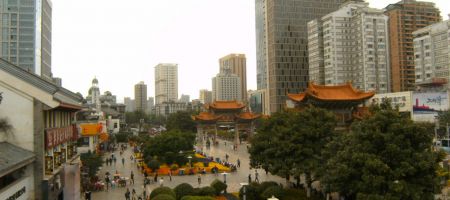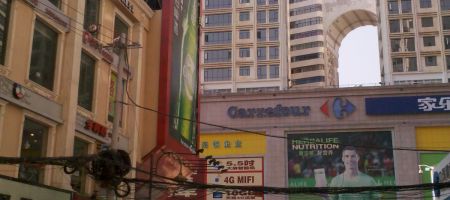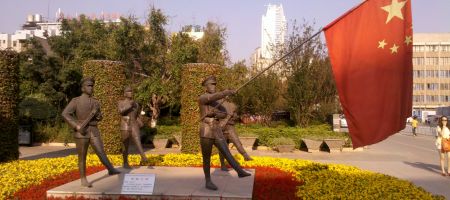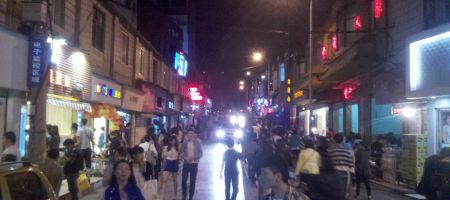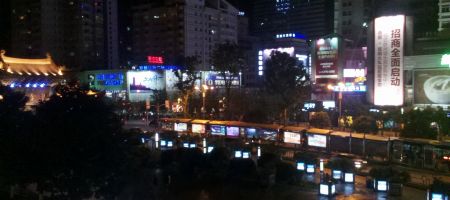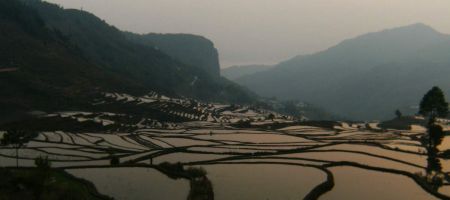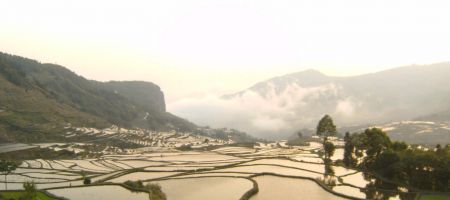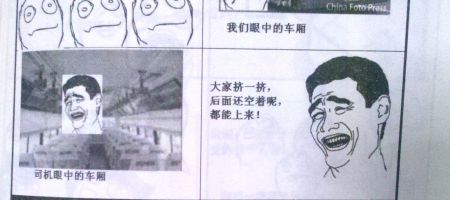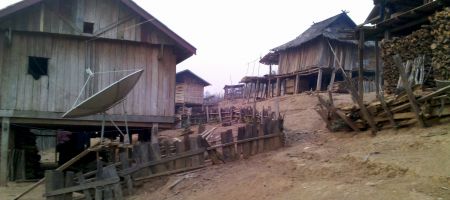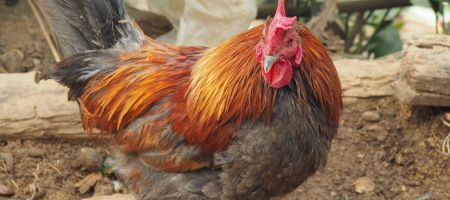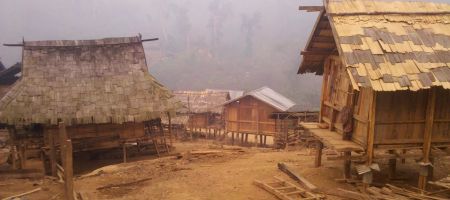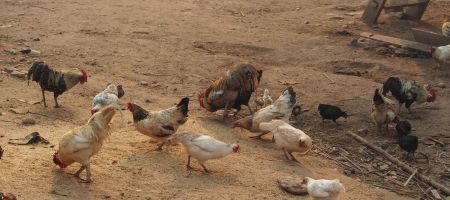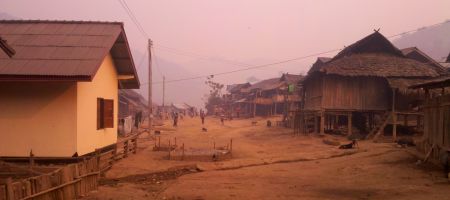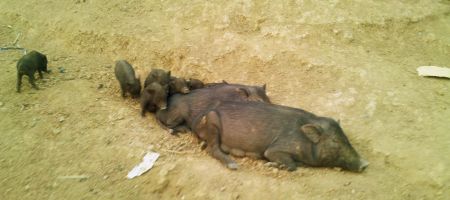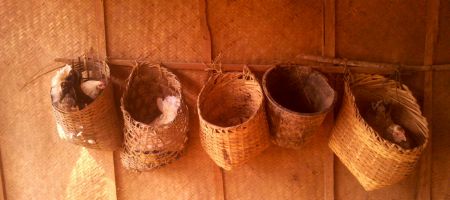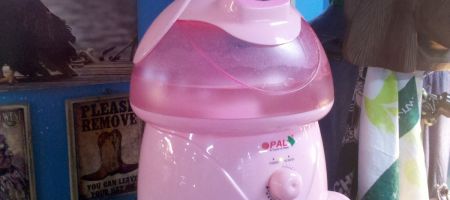Freaky
Let’s have a ride!
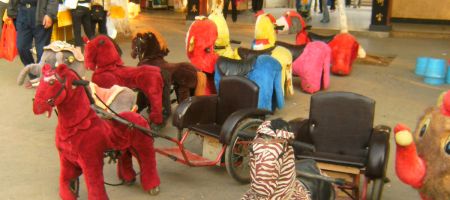
On self-made electro-motor driven ride-a-ponies. How cool is that? I can’t help though to find them a bit creepy in their slightly tattered but colourful composition.
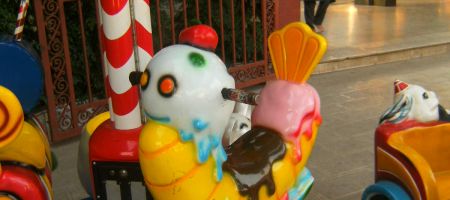
Or, let’s have a ride on living banana split with chocolate, vanilla and strawberry ice cream with a cherry on its head! Oh wait, oh god, it’s melting!
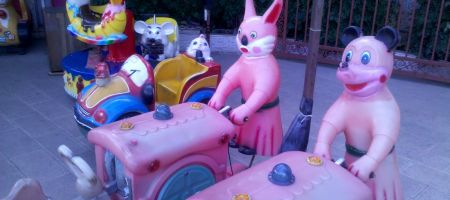
Okay, then lets get on this pink seesaw for … only one child? Where your playmate is a robot either disguised as a pink deformed Micky Mouse or a giant pink rabbit? Argh those eyes, they keep staring at me!
Well, there is still the choice to ride in that colourful car with that broken nose… No wait, what is this creeping up behind me?? A white slime thing with a pipe in its mouth and a sirene on it’s head?
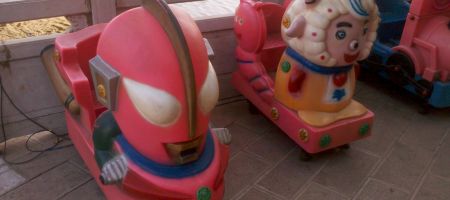
…that’s it! I’m getting into my tank!

Kunming
Ever heard of Kunming? No? Well, it is a modern metropolis with 7 million inhabitants and is the capital of Yunnan. Yunnan is a mountainous province in south China which itself is bigger than Germany.
Kunming is not one of those third world mega cities with endlessly sprawled out slums in the suburbs whose city center look much much smaller than one would expect it considering the size of the city. Rather, Kunming reassured my first impression of China (or rather Yunnan) how modern, civilized, clean and rich it looks.
One thing I noticed is that in the bigger cities in Yunnan, most motorcycles, transporter motor-rickshaws and city-cars have an electro motor. The difference in noisiness and air pollution within the cities is noticeable.
A reason we Europeans are so ignorant of China might be that in our heads we classify it as one country (think of certain statistics about e.g. pollution produced). But by area, population, history and culture, it should rather be looked at as a cultural zone in the same class of the whole of South East Asia or Europe. China is about as big as Europe – only unified under one rule.

Dusk Illusory Image
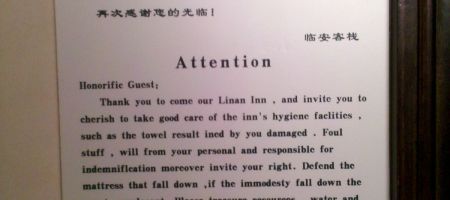
In the shower of an upmarket hotel. Defend the mattress at all costs!
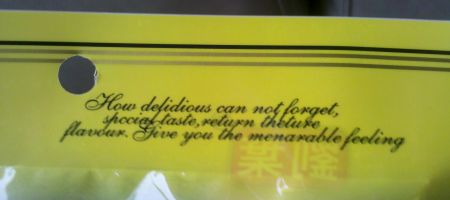
On a snack package with dried peas. They don’t even bother to consult a dictionary, google translate or something before they put this on thousands of packages.
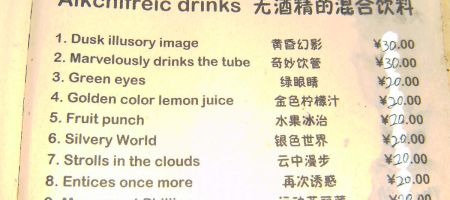
In a menu at a restaurant aimed at tourists.
And here are some more highlights I found in restaurant menus:
- Noodle-Soap
- Plane rice
- Palace of explosive cabbage
- Rape soup
- Unrestrained lorer
- Papaya milkshake, please
I hereby solemnly award China the Guinness Book of Records title
“Country with Worst English Translations”.
This really shows how European languages and Chinese languages are quite incompatible with each other.

Xinjie and Jianshui
Just some pictures from Xinjie, famous for it’s photogenic rice terraces:
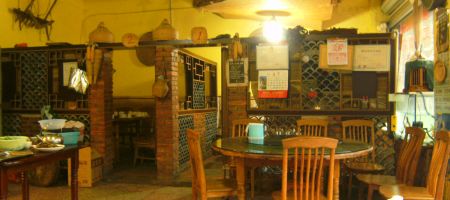
In a cozy restaurant in central Xinjie during a thunderstorm. Xinjie (22°C) was a nice change in climate to the tropical heat in Thailand and Laos (34°C) but I think we all got a cold during the cold nights there.
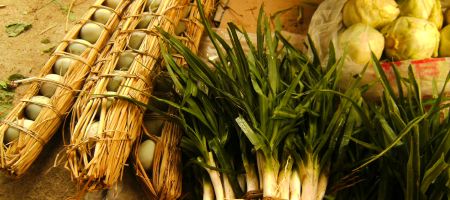
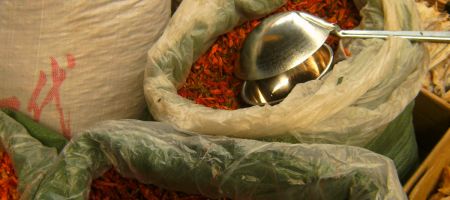
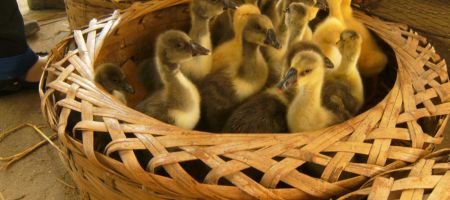
On the market in Shengcun, a village of the Hani ethnic group. Just like in Laos, the Chinese Yunnan province (which itself is as big or bigger than Laos) is full of ethnic minorities – one reason this province might be counted culturally to Southeast Asia rather than China.
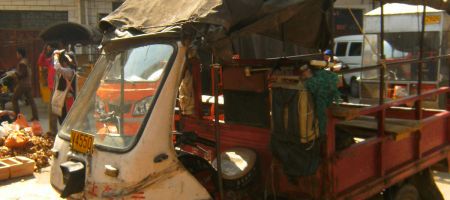
A three-wheeler used as a shared taxi. Sometimes they are also used as small transporters, depends on the current needs. In Thailand, this thing would be called a small songthaew (=“two rows”) because there are two benches for passengers on the left and on the right.
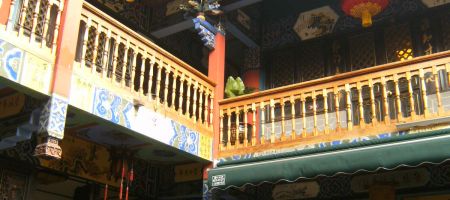
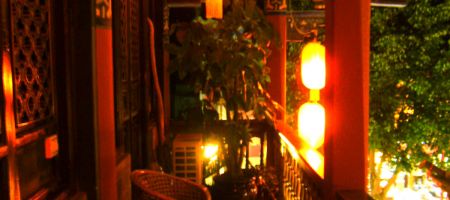
Two shots of our lovely hotel in Jianshui

…in which we found a “Steve Jobs” memorial hair dryer. ;-) An iFön
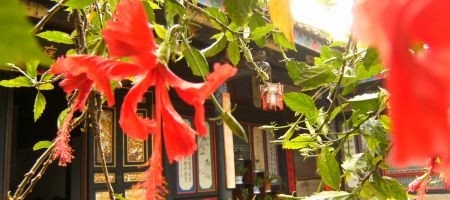
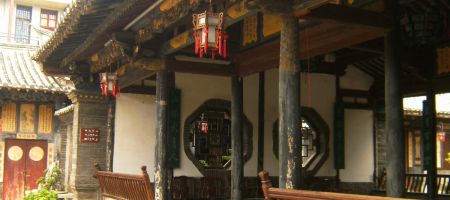
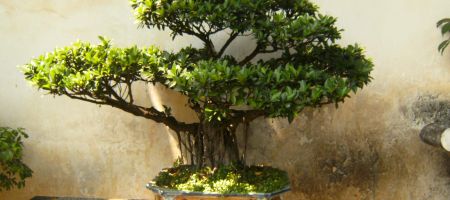
The main attraction of Jianshui is a large old mansion (“Zuh’s Garden”) in the city centre that has been renovated into a museum.

Journey to the North
When we crossed into China, it was quite a shock to see how different, how civilized and clean it is compared to Laos. Suddenly, villages along the roads no more consisted of scattered thatched bamboo homes on clearings of otherwise untouched jungle. Instead, we saw solid brick and concrete apartment buildings in even the smallest villages. Most land visible from the roads was cultivated and if not, consisted of shrubbery or at most secondary forest.
And, construction sites everywhere: Not only in the villages and towns. Modern motorways were being constructed with uncountable bridges over the valleys and tunnels into the mountains.1
The journey to Yuanyang was quite off the beaten path: First of all, the Chinese-Lao border is not really frequented that much (yet, see footnote); then, we chose to travel through the mountains in the southern border region stopping in Mengla, Lvchun and Nansha. Most people use the highway from Jinghong to Kunming.
So, nothing in the region appears in any travel guide I know of. It took us almost three days of bus travel through this region of Yunnan on partly bloodcurdling serpentine roads to reach Yuanyang from Luang Namtha in Laos. Bloodcurling were not only the roads but also the overtaking manoeuvres of the bus drivers into curves on roads that were barely broad enough to allow two buses to pass each other comfortably.
But, we survived. And, the journey gave us a funny insight about this part of Chinese culture. A topic I seem to be very fond of, looking at the many articles I wrote already about public transportation.
In the bigger buses that featured a DVD player, our rides were riddled by various Chinese TV series marathons. The worst being some military-themed soap opera with annoying young women as main characters.
Also, the people that live in this region seem to have a weak stomach. For the most part, the roads were not that bad, still, I think we were in no bus in which not at least one person had to vomit.
Concerning the other end, the roadside toilets at the villages were also quite the sight. After some more surveying, I can say that the public toilets in Yunnan are the worst so far I’ve seen in South East Asia. Those roadside toilets, those that were still standing or not being used as a storage house, were small concrete boxes that looked and smelled like converted pig stables. Often, the ground was already covered in leaves and dirt. There were no cabins, instead people would relieve themselves into a gutter ditch next to each other. This lack of privacy while doing your business seems to be something the people don’t care that much in Yunnan because even if there are cabins in public toilets, often either the door is missing or the lock is broken.
Really, a simple hole in the floor of an otherwise empty room seemed to be a luxury compared to these toilets. ;-) (No toilet paper and no soap is standard, nothing I’d notice anymore.)
When we got back to Thailand, Lena made a comment about that “one can see by looking at the row of women at the lavatory putting on new thick layer of makeup that one is in Thailand. While in China, the women are more like ‘eww gross, lets get out of this place fast!’”
Our bus driver also had a retractable tin bong which he popped out on every occasion to smoke, as did half of the male passengers (without bong though). China is one of the few regions left of the world where everybody smokes, inclusively in public places and on buses.
Like for breweries in south Germany, every larger town in Yunnan seems to have a cigarette factory – sometimes recognizable through their cigarette-shaped main building.
Apparently, the bus drivers are only allowed to load up a certain amount of people into their bus – as many as there are seats. The maximum load is controlled in the cities by the police and at the bus station. So, what do the bus drivers do?
What they do is to load up this many people at the bus station, drive out of town, pick up some stools at a friend’s house to put into the gangway and suddenly there is enough place for at least 10 more people. The money paid by the extra passengers presumably goes directly to the bus driver. That pays off.
Since every bus driver does it, I think they even warn each other of police cars being around with a sign language when passing each other. When a police car approaches the driver tells the extra passengers to duck so that they won’t be seen.
Incidentally I bought a comic book named “Rage comics” in a bookstore in Kunming. It just includes Chinese rage comics copied together from the internets. Very rough translation of this one:
1. While getting on the bus
2. From the viewpoint of the passengers
3. From the viewpoint of the bus driver
4. “Come all in, there is space left in the back!”
In the next article: Our destination, Xinjie. Or, why it was worth the trip.
1 China and ASEAN have big plans in that region. Together, they are building international highways and railways that connect China with the ASEAN nations over land. This is an enormous undertaking as the region is a mountain range. And as Laos has no money for that, I heard that Chinese businessmen are building them with a similar banana-deal as when the railway was constructed for Costa Rica back then (See history of Chiquita).

Adventures of Longleg - Part II: Pigs and Television
In the late afternoon, we arrived at the village inhabited by people from the Akha ethnic group, Nam Lo, population 500. The village was quite the culture shock. I think I have never seen so many animals, pigs, chicken, dogs and cows in one place. So many children, it looked as if the place was run by them.
We were shy to make photos of the people, so the only photos we have are very early in the morning with few people on it and a few from some animals running around freely in the village
Our guide told us that a dirt road leading up to the village as well as a power line and a few wells (taps) were just finished one year ago. A school had also already been built. Toilets are in planning. To see the changes rushing into the village now is very interesting, if not a bit sad:
Traditionally, their houses are completely built out of wood and bamboo. Now, the road made it easier for the villagers to acquire sturdier building materials from the town, most of all corrugated iron or pantiles for the roofs but I saw a few concrete beams lying around near the village’s toilet.
Traditionally, the Akha are nomadic farmers: They build a village, burn down the jungle around it and do a few decades of farming until the ground gets too barren. Then they move on and build a new village some kilometers away. The road, the wells, the electricity and longer-lasting buildings all contribute to the development of them to settle down and in turn keep them from burning down the jungle.
The road also brought Chinese businessmen with it. In the interest of the government, they provide the Akha with another crop to grow, a crop that is undemanding enough to make it unnecessary for them to do slash-and-burn cultivation: sugarcane. Our guide was not sure though if that plan was a good solution to the slash-and-burn-problem because the price the Chinese were willing to pay for the sugarcane now is less then they were promising and it is falling further. Reminds me of the coffee plantations in the Americas during colonial times.
I also discovered woodworkers further up beyond the village, at the end of the road. Well, I guess in comparison felling the trees for money to buy cheaper food from the fertile lowland is more sustainable.
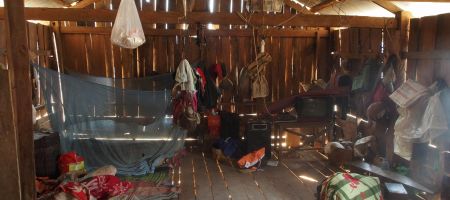
The common room of our host’s house. The house had two rooms, kitchen and common room. Like all the other houses, it is built on stilts. The area below the house is where the firewood and other stuff is kept.
The prime use for electricity are electric light and television. (Mobile phones is something they probably already had before: There are small mobile communication towers around that solely work with solar panels attached to the top. One mobile network has reception there.)
The biggest change, a cultural change, a change in ideas, morality, cravings and consume behaviour is in my opinion brought by the television. The family we stayed at was one of the few homes that already bought themselves a TV. I don’t know what the family used to do in the evening when they returned from the fields and woods one year ago, but when we were there, their entertainment consisted of zapping around in the various Thai and Lao TV channels. We had the impression that the advertisements were amongst the more interesting things for them. Not too surprising, in my opinion.
Only our host, an Akha soldierman actually interacted with us. Excluding the grandma, who was smoking (probably) opium the whole time in her corner, the rest of the family was under the spell of the TV.
After dinner, we sat together with the soldierman, his wife and our guide and played spin-the-bottle as a drinking game for Lao Lao (the wife did not drink). A little unsettling was that actually it was not a bottle that was spinned but the fried head of the chicken that we ate for dinner earlier. I watched the chicken in its long death struggle: They kill them here by strangulating them.
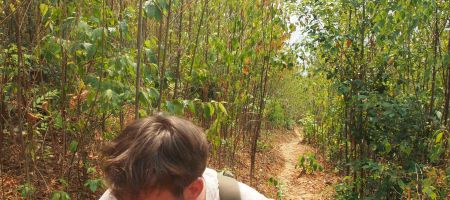
Day two surprised us with an hours long steep hike up the mountain at 34°C on a cloudless day.
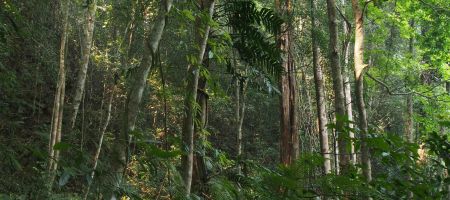
… and a walk through some proper primary forest, jungle.
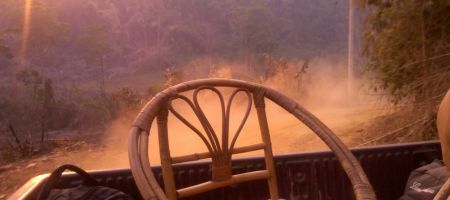
After we reached the road, we drove back to Vieng Phouka in a pickup. Those wicker chairs were for intended for us to sit on. After an almost-accident with an overtaking truck that was heading for a head-on collision with us and our driver’s abrupt evasion manoeuvre, however we sought it to be safer to sit on the floor. Chris almost fell off the pickup there.

Adventures of Longleg - Part I: Slash and Burn
In end of March, our friends Sanne and Chris came to visit and travel with us. After some destinations in Thailand, our journey took us to a small village named Vieng Poukkha in Laos. From there, we went out to do a two-day trekking trip into the Nam Ha National Park. Lena stayed in Huay Xai to fulfill a long-time dream of her, to do the Gibbon Experience.
The tropical hot season (up to 37°C) is perhaps not the best time to do a trek like this, but actually the second best. The rainy season is only up to 5 degrees colder but so humid that it feels at least as hot as in the hot season. Plus, of course, the paths become all muddy and slippery.
And finally, after almost one year in Thailand, I was awarded a Thai nickname: After I jumped over a few streams during the trek (instead of balancing on stones sticking out from them), the guide started to call me longleg1 :-)
Here are some photos of the trek:
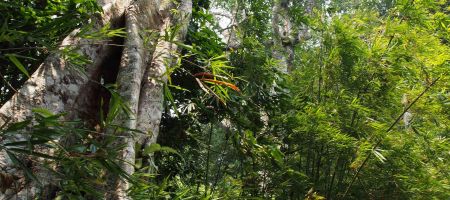
Just a massive rainforest tree with a strangulating vine around it
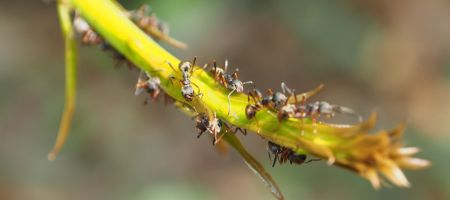
An ant highway leading up a cut branch
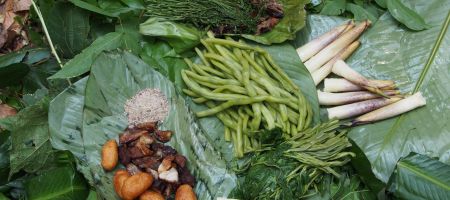
Lunch break on the rainforest floor. From left to right: Some sweet deep fried stuff from the market, bony pig meat, spice mix (mainly salt and chili), local spicy meat and veg., beans, spinach-y vegetable and the rightmost stuff is actually bamboo sprouts. Bamboo is such a versatile plant. The sprouts taste quite bitter, the sweetest part a bit like asparagus. Pickled bamboo sprouts are absolutely delicious!
In the afternoon, we got near the Nam Lo Akha village, our destination for the night. However, when it came into sight, we saw this. Fires, smoke and ash wasteland:
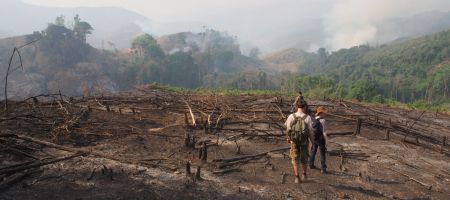
If you zoom in, you can see the village in the distance, shrouded in fog.)
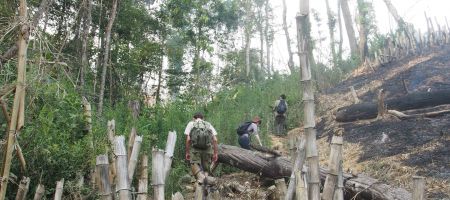
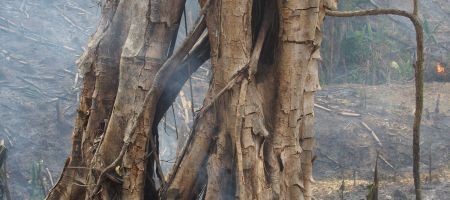
A strangulating vine which has long since killed its host tree and got strong enough to stand on its own probably survived the fire as the only tree around.
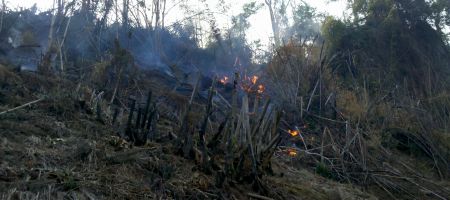
Many areas of the wasteland we were walking through were still gleaming, in others there were fires still. Burning bamboo cracks so loud, it sounds like gunfight.
So, what happened? Did the village and the whole area surrounding it burn down? No. The people from the village were just burning down areas surrounding their village for slash-and-burn cultivation the day we arrived. Our guide told us that this happens perhaps every 12 years or so (to that extent).
The ground in the mountainous regions in Laos is not very fertile, so the ethnic minorities who live there burn down areas of the jungle regularly to use the ashes as fertilizer. Needless to say, this is not exactly sustainable.
During the first day we walked through different areas that were burned down at different times in the past, it was interesting to learn how long a forest needs to regrow in this latitude:
A former village burned down 10 years ago (by accident). The area is now covered primarily with grass, shrubs and small trees up to 3m height.
Another area that was burned down 20 years ago is now covered in a dense bamboo forest – bamboo sprouts like mushroom (or rather, mushroom sprouts like bamboo? I heard there are types of bamboo that can grow up to 1m overnight).
Left untouched for 50 years, another area already looked like a forest again, but the trees were all quite young and not very large.
Another area in which also a former village stood was left untouched for more than 100 years. This area definitely looked like a rainforest again. However, it was easy to tell it apart from primary forest as the really big trees were missing and the forest was not really dense.
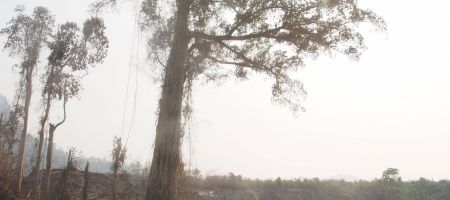
This huge tree survived the fire. Click the thumbnail to see a size comparison with a human. I can only guess its age, perhaps 500 years? 1000 years? How many trees of this size fell to the fire?
1 More spoken like lohläh. Thai and Lao always slur syllables.
So, Thai’ised English words are sometimes barely recognizable when translated back to English. Like “döhn” (modern, in fashion), “äbbön” (apple), “fränfry” (french fries), “motosai” (motorcycle) or “attanomat” (automatic). A constant hitch for Lena an me when we want to go home and have to tell the taxi driver the name of our apartment complex: “Golf View”. They understand it best when spoken something like “Gopbiu”.
Comment [1]

Stalkerphone
So the Chinese electronics company Oppo released the N1, a smartphone with a revolving camera. And in Thailand, they are advertising with this:
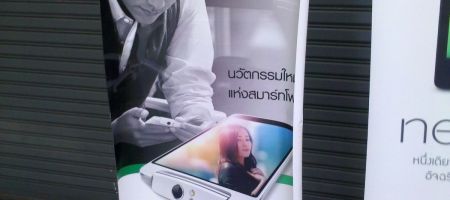
“Dumdium, I am just looking something up on my smartphone and I absolutely do not secretly make photos of you”

Piggy Vaporizer
Found this pig-styled vaporizer in a shop in mall at Victory Monument, Bangkok. Before you ask, it luckily did not disperse pig scent like those Bacon Air Fresheners ;-)

Happy New Year 2!
Remember that title? As India has its own New Year, Thailand has it as well.1
It is Songkran (click for google images)! A massive nationwide water fight. Of course as with our New Year, the most action is in the cities. Banglapoo (Khaosan), the backpacker area in Bangkok was madness.
We just came back from China (blog posts later), so we almost missed it. I could only made a few photos until it got dark on the last day. The water fight went on, but it got too dark. So, have a look at the photos on google or alike.
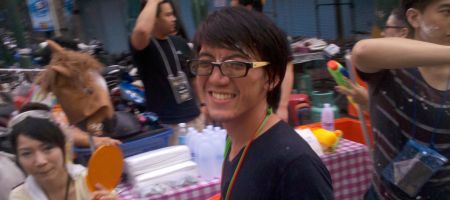
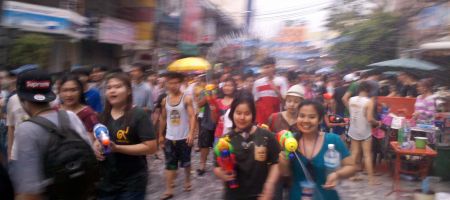
Near Khaosan road
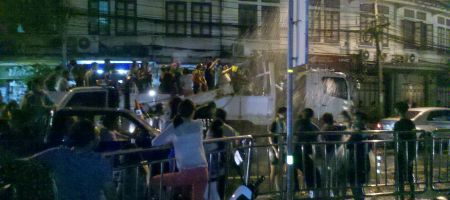
There were many people on pickups, trucks and auto tuk tuks driving around and splashing water everywhere. Seconds after I made this photo, a pickup with a load full of people and two big water containers on it “refueled” at the water hose in the front.
1 Doesn’t stop them to celebrate the Western New Year also though ;-)

